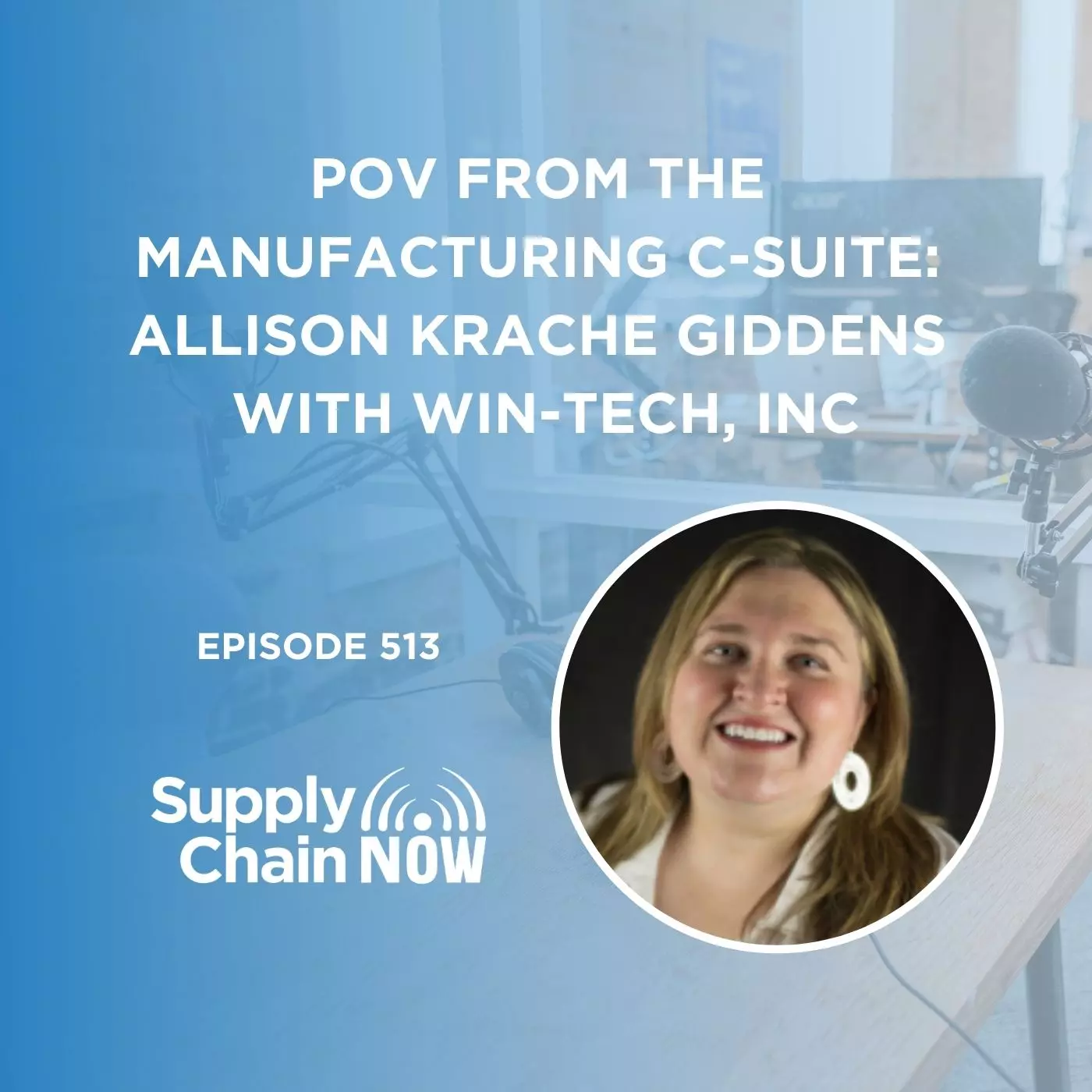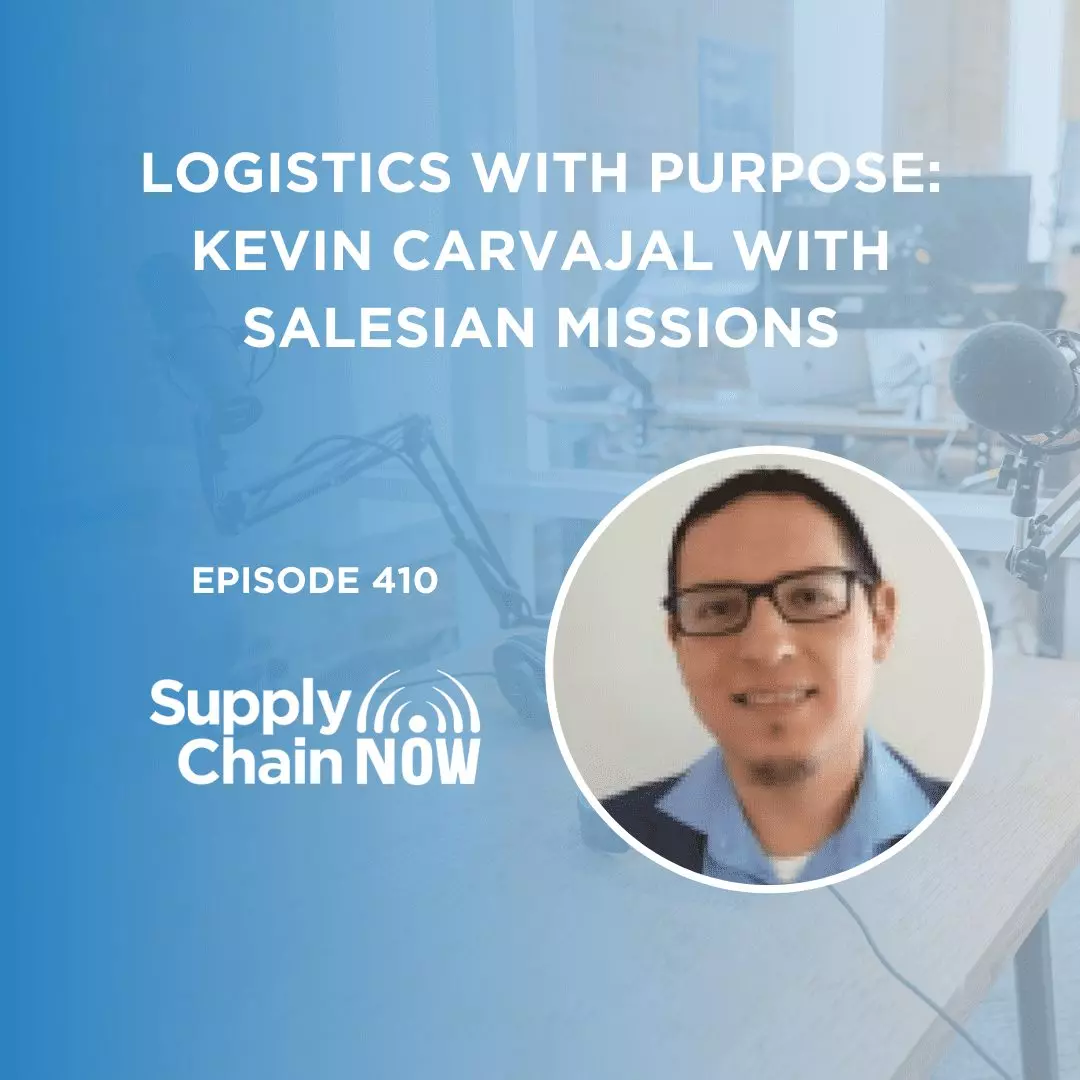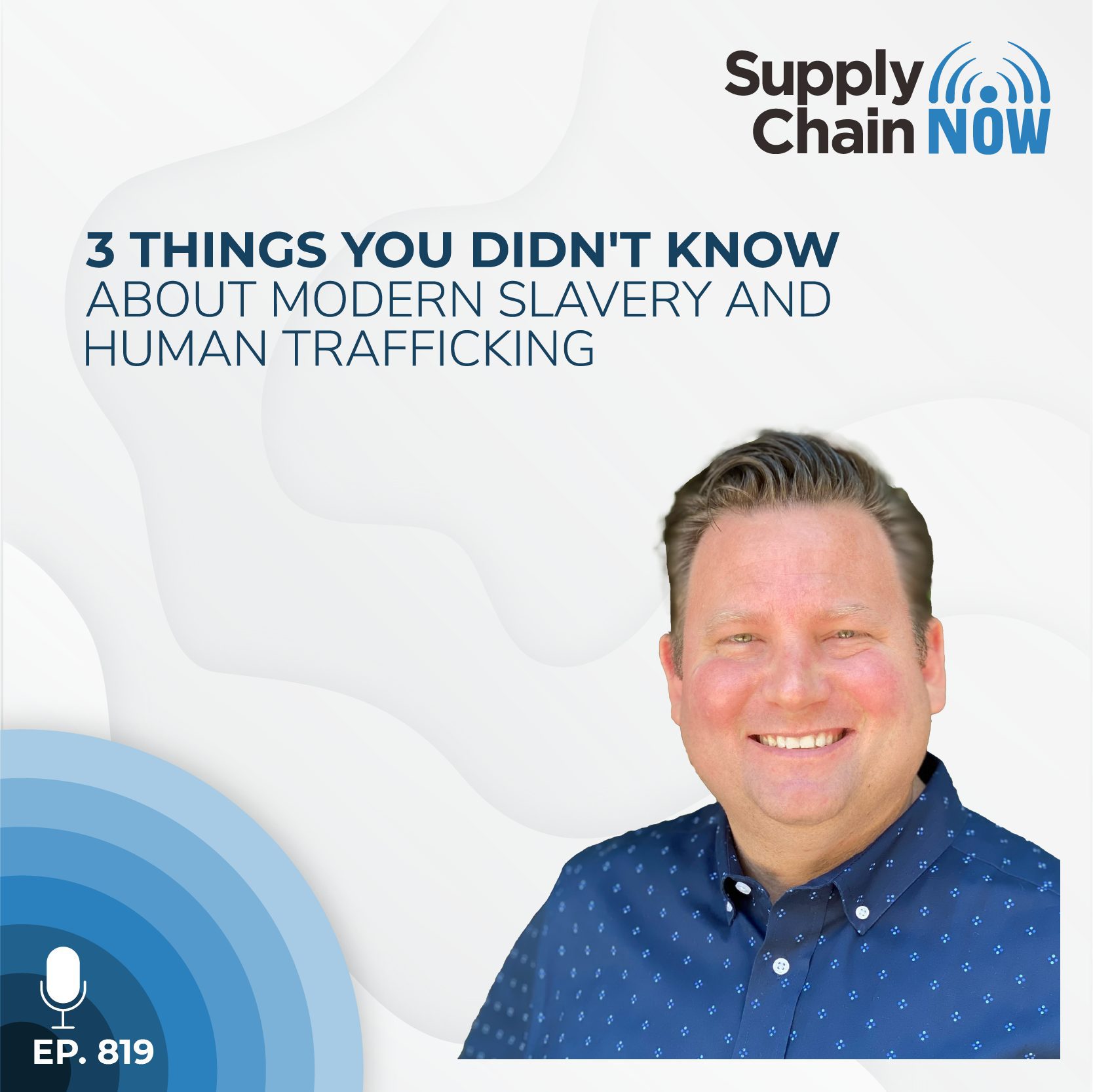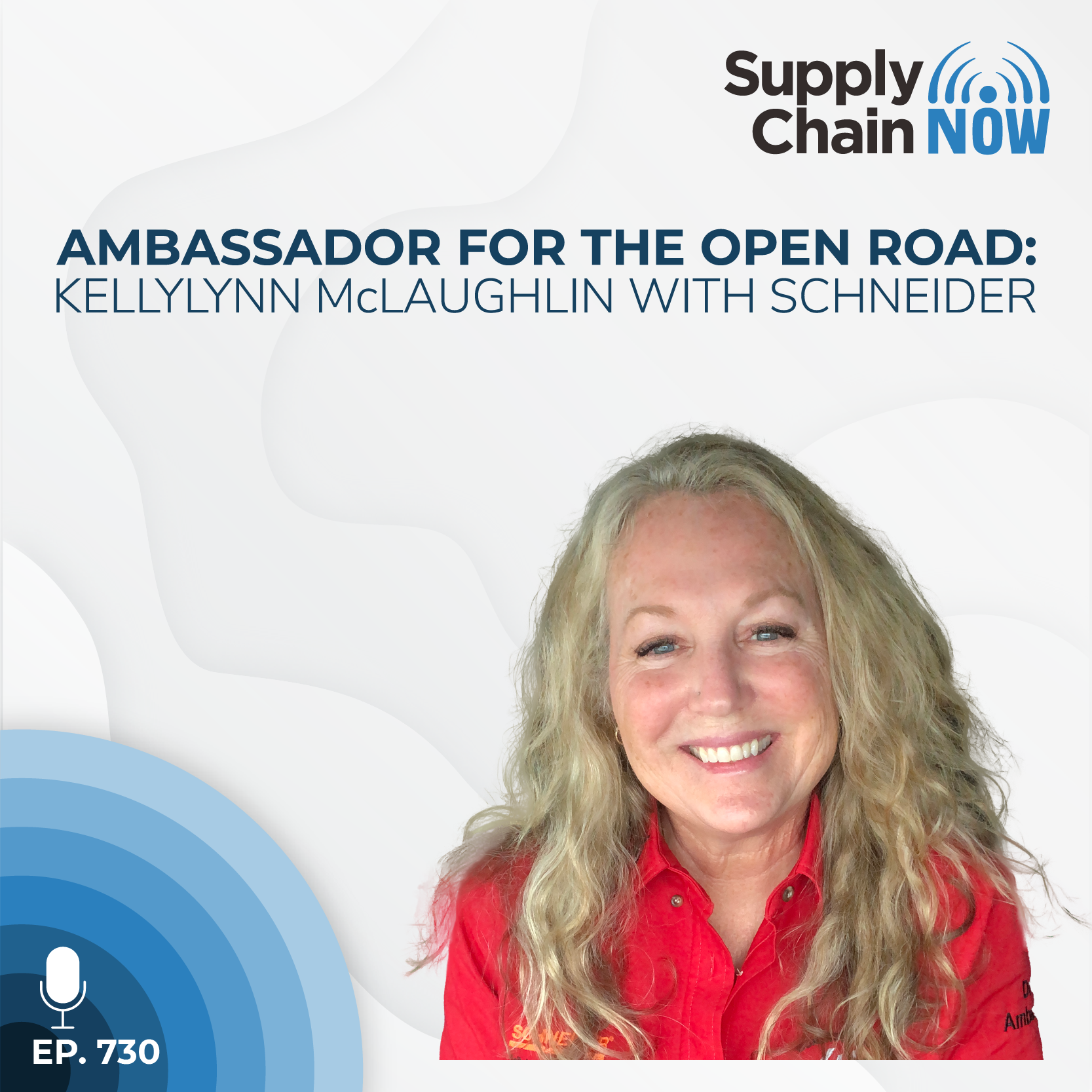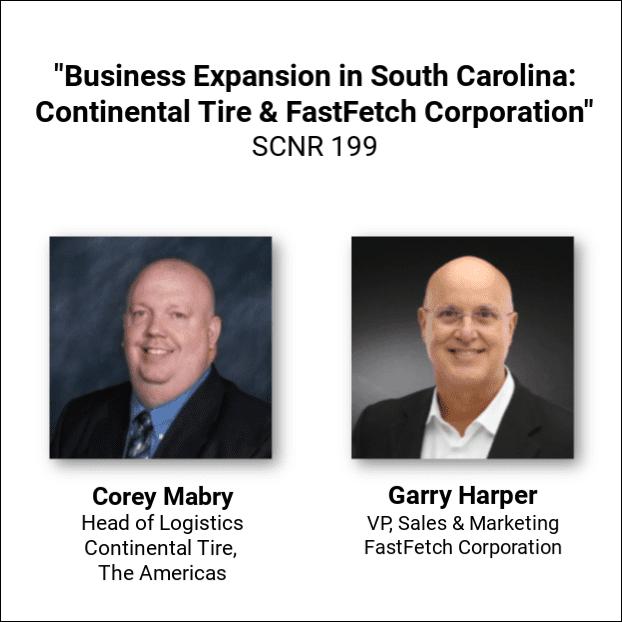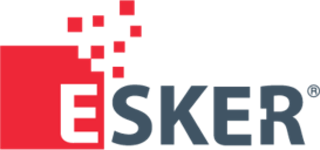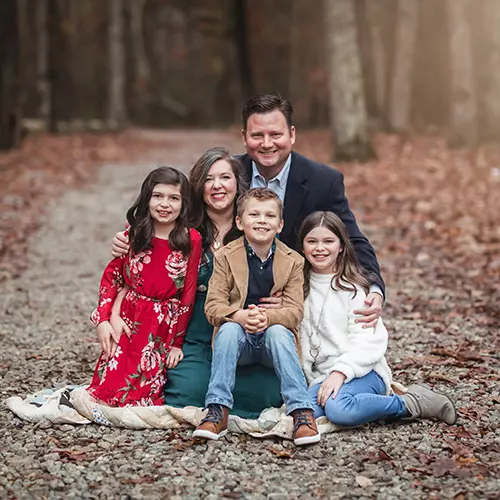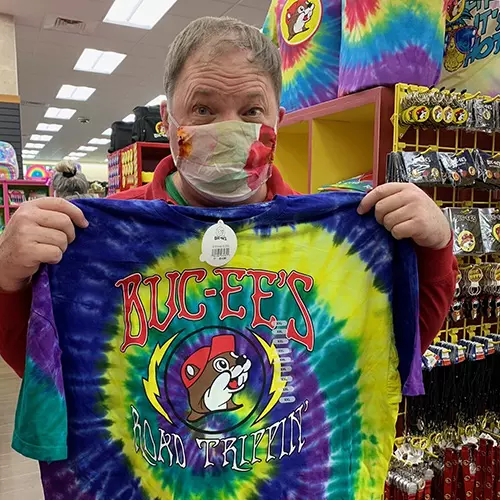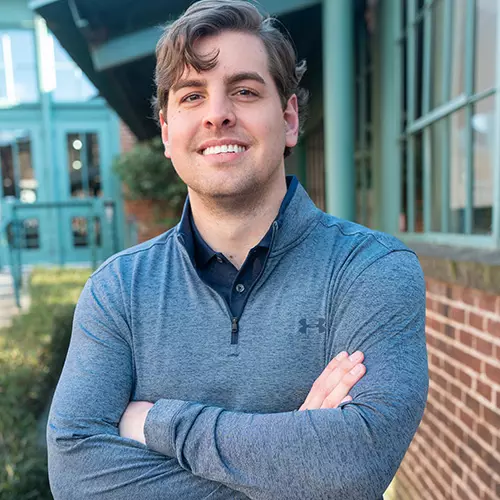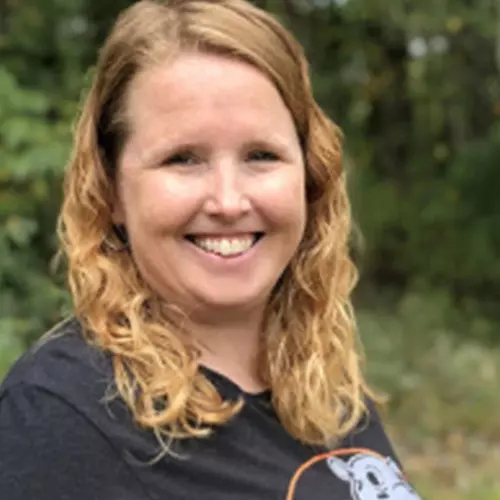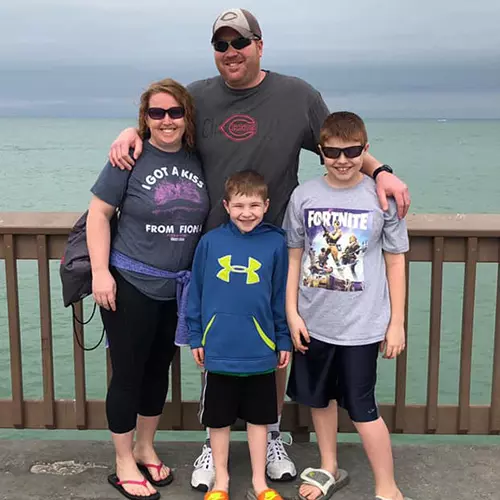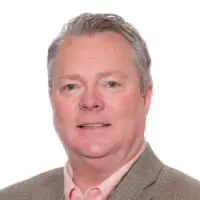
The whole point of the WES system is to move product through the warehouse to the proper spot so it can then ship and get out the door. That's where having that integration and knowing where something has to end up allows it to be placed in the proper spot within the warehouse, in the proper hands, on the proper conveyor, etc.
-Shannon Vaillancourt, President of RateLinx
Episode Summary
Modern warehouses need seamless integration between order release, picking, packing, shipping, tracking, and audit. This creates a closed loop of information on supply chain deliveries and makes it possible to support all modes of transportation in a single software platform.
Without a real-time full-featured Warehouse Execution System (WES) or a Tier 1 WMS integrated into a multi-modal TMS, shippers are wasting time, money, and opportunities to optimize both their customer experience and transportation deadlines.
Shannon Vaillancourt is the President of RateLinx and a 30-year industry veteran, and Dan Hanrahan is the CEO of The Numina Group. They have seen firsthand how automating warehouse and transportation execution into a unified operation makes it possible to achieve real-time visibility and automate the selection of parcel carrier and LTL shipment modes.
In this livestream-based session, Shannon and Dan join hosts Scott Luton and Greg White to discuss ways automation can reduce freight spend:
• Using real-time carton and case order dimensional weight visibility to automate carrier cost selection across all modes of transportation.
• Managing by exception to allow software logic to manage daily shipping optimization activities
• Automatically selecting the lowest holistic cost using rate shopping and auctions to make transportation into a profit center
• Removing the subjectivity in carrier selection to identify the lowest-cost qualified carrier
Episode Transcript
Intro/Outro (00:03):
Welcome to Supply Chain Now, the voice of global supply chain. Supply Chain Now focuses on the best in the business for our worldwide audience, the people, the technologies, the best practices, and today’s critical issues, the challenges and opportunities. Stay tuned to hear from those making global business happen right here on Supply Chain Now.
Scott Luton (00:31):
Hey. Hey. Good morning, good afternoon, good evening. Scott Luton and Greg White here with you on Supply Chain Now. Welcome to today’s livestream. Gregory, how are we doing?
Greg White (00:40):
I’m doing very well. Do you think people know that I have two backdrops? Do you think they ever wonder what that is?
Scott Luton (00:49):
There’s a lot more than two backdrops. But I bet, yes, they know Greg White and they know you’re a huge Kansas City Chiefs fan, the reigning NFL Champions. Is that right?
Greg White (01:01):
Yeah. I am so stoked because the schedule comes out tomorrow. I know it seems like football hardly ended. And, frankly, I think it’s too long between seasons. And the Chiefs are playing in Germany this season, so we know when and with and against whom now.
Scott Luton (01:20):
Well, it’s really interesting how the NFL’s built this dripped out marketing theme, but we’ll save that for the sports show. I am stoked, Greg, about this great discussion we’ve got teed up here today focused on four ways Transportation Management Systems, TMS, can collaborate with Warehouse Execution Systems, WES, to offer up the best holistic decision, saving time, money, headaches, and, Greg, empowering your people to be more successful. It should be a great show, huh?
Greg White (01:51):
Yeah. It’s always good when we can bring our favorite – I don’t know why we delay announcing who’s on the show. We promote it for weeks on end beforehand. So, it’s always great when Shannon Vaillancourt is on the show. He’s been doing it forever, evolving with the time and staying ahead of the game. So, we’re going to get to hear from him and a close partner of his. So, that’s going to be hugely valuable. Listen.
Scott Luton (02:13):
That’s right. Listen up as Greg is known for saying – hey, that special friend, Dan Hanrahan with ofThe Numina Group. So, we’ve got quite the dynamic duo here today. And, folks, hey, you’re going to hear a lot of expertise and perspective and analysis here today, been there, done that perspective. But we want to hear from you, too, so use the comment section, the cheap sheet – the cheap seats – if I can say that right – to share your voice.
Scott Luton (02:40):
Speaking of, Greg, shoutout to a few folks here. Jerry from Georgia, tuned in for two in a row via LinkedIn. Great to see you, Jerry. Harish tuned in via LinkedIn from India. Welcome. Welcome. Jen is tuned in from Denver this morning via LinkedIn. Great to see you, Jen. Sarika – I think I got that right. If I didn’t, hey, if we get any names wrong, let us know, as always, Greg. Sarika tuned in from South Africa via LinkedIn. Great to see you. Fredreck from Zimbabwe. Salimo via Mozambique. Greg, Glorimar —
Greg White (03:13):
Wow. Africa is represented today.
Scott Luton (03:15):
That is right. That is right. Glorimar is back with us from LA. Welcome, welcome everybody, and keep the comments coming. We got a great discussion teed up here today. All right, Greg. We have got two wonderful guests. I’m going to introduce them and then we’re going to get to work. How’s that sound?
Greg White (03:34):
Yeah. The introduction sounds great. The work, I’m not so – no. Of course. Let’s do it.
Scott Luton (03:40):
All right. So, with no further ado, I want to welcome in our two featured guests here today, Dan Hanrahan, CEO of The Numina Group, and Shannon Vaillancourt, President of RateLinx. Hey. Hey,. Shannon, great to have you back. How are you doing?
Shannon Vaillancourt (03:53):
I’m doing great. How are you guys doing?
Scott Luton (03:55):
Wonderful. Wonderful.
Greg White (03:55)
Great.
Scott Luton (03:57):
And, Dan, welcome.
Dan Hanrahan (03:59):
Greetings. Appreciate the opportunity to join Shannon and yourselves and have a great conversation today.
Scott Luton (04:06):
We have a wonderful conversation, aren’t we, Greg? Now, Greg, in the pre-show, man, I mentioned the NFL, which we lit off here with, and the three of y’all took it over. We could have had an NFL Blitz Power Hour in the pre-show. Lots of passion.
Greg White (04:20):
Well, it was a little bit of a support group hour, right? I think, all of our teams are better than they did in the past, but we all had to express a little bit of pain there.
Scott Luton (04:34):
Well, we’re going to use that as our fun warm-up question here with Shannon and Dan and yourself. And, hey, Ahmed, Farrah, Tracy, all of y’all, if you’re NFL fans, let us know your favorite team. So, Dan, we understand – given this is your first time with us here, we’ve done a little homework on you – you’re a huge Chicago Bears fan just like Shannon. Now, this is just my opinion, I’d say that ’85 Bears is probably the best in NFL history, even if they weren’t the undefeated, like the Dolphins were back then. But what is your favorite or one of your favorite Bears players of all time, Dan?
Dan Hanrahan (05:12):
You know, and that’s what you have to do, you got to reach all the way back to 1985 to pick one of your favorites, and that’s Dan Hampton. And, really, the thing that reminds me the most of Dan Hampton is he just gave it all. In his last game, the Bears lost. They were going downhill. It was probably four or five years after the Super Bowl. And there it was, I think they were playing the Jets – the Jets or the Giants. Boy, I can’t remember exactly – and he was fighting for the last six inches to stop them from scoring. And that was his whole drive. And that was the last play he ever played when they scored on him. So, I’ve met him a couple times. He’s got some issues at times before. What a 100 percenter, you know, he gave everything in football.
Scott Luton (06:02):
Heck of a player. Mountain of individual too. All right. So, Shannon, before I come to you, we got a bunch of fans here. Ahmed, “Bear down.” Scott, “Da Bears.” Joe Hanrahan – who might be related – also a big Bears fan. Farrah, “Falcons and Texans.” Roderick, “Dolphins.” And Michael, “Who Dey.” I think we know who that is. All right. So, Shannon, you’re a big Bears fan, one of your favorite Bears players of all Time, Shannon?
Shannon Vaillancourt (06:28):
Boy, I mean, you go back to the ’85 Bears, of course, that’s an easy one, probably Walter Payton. You know, I had the pleasure of meeting him at training camp in 1986, A&W Platteville. You know, a friend of the family was assistant football coach at Platteville, so I got to meet pretty much all of them back then, which was pretty neat. I mean, all of them back then. And then, you go up to their locker, the next round, Devin Hester. You know, I’m just a huge, huge Bears fan.
Scott Luton (07:06):
Yeah. Hester, man, what a return specialist. Okay. Greg, we’re trying to keep this from becoming – we can talk NFL for the next several hours. Greg, the Kansas City Chiefs, one of your favorite players of all time.
Greg White (07:20):
The favorite player of all time is Derrick Thomas. If not one of the greatest past rushing linebackers in the history of the NFL. But I have to throw a shoutout to Mike Singletary in Chicago’s, because at that time, my family was living in Chicago. What an incredible time in that city. Still, I will argue to the death that’s the greatest defense the NFL has ever seen.
Scott Luton (07:45):
Good stuff there. Monsters of the Midway. All right. So, a lot of good stuff. Thank you, Greg, Shannon, and Dan for playing along. And, hey, Jerry, yes, we’re going to dive into, as he talked about, we’re going to define warehouse execution system in just a minute, and kind of speak to more of your questions, so you’re in the right place. So, stay tuned.
Scott Luton (08:04):
But before we do that, you know, context is so important in this modern digital age. Always has been important, but as fast as conversations can take place and information come at you 2,000 miles an hour, context is critical. So, I want to give Shannon and Dan both an opportunity. You know, both of y’all have been powerhouses of thought leadership, doing big things in industry for decades. We’d never go over two decades. Is that right, Greg?
Greg White (08:31):
That’s right. We never confessed to two decades. Though, I think if you look at any of us, it’s pretty obvious.
Scott Luton (08:37):
Right. So, Dan Hanrahan with The Numina Group, tell us a little bit about what you’ve done in your career as we set the table here on the frontend.
Dan Hanrahan (08:46):
Well, my entire career since I’ve been out of college has been in the automation space. So, I started in process automation, worked selling and implementing as a project specialist, distributed control systems. And from there, I left that company, went to work for a smaller independent firm. And during that time started The Numina Group, so I was the founder of the company. And it was mainly in the process automation industry and software-centric at that time, so we started really in connecting instrumentation, connecting devices. And that’s exactly what we do today, but a much more sophisticated stage, connecting automation and components within a warehouse operation. That’s my whole life. It’s kind of my other hobby besides football.
Scott Luton (09:36):
Well, two quick thoughts there. Automation before automation was, not only cool, but absolutely critical. And then, secondly, you made a remark in the pre-show – and hopefully, I’m not telling on you – we are talking about a smile on someone’s face here and you were like, “That is as excited as software engineers get,” if I’m quoting you right. Is that right, Dan?
Dan Hanrahan (09:59):
It is. It is. You know what’s really interesting, I think you’ve set the stage where both of our companies have continually evolved and looked at where are the savings, where are the value proposition to a customer, because that’s really most important. People invest in automation for return on investment and, really, for bettering their business, so both of us are really focused on that. And it’s a fun passion. I guess that’s what does get me excited is seeing a customer success when you’ve delivered the right solution for their application.
Scott Luton (10:32):
Well, that’s the perfect segue over to you, Shannon. Shannon, we’ve been fortunate to have you with us here on a couple of these conversations, of course, your decades of action-oriented leadership out in the industry. You never talk about yourself, Shannon. Tell us a little bit about what you’ve done in your career.
Shannon Vaillancourt (10:49):
The topic I love to talk about. You know, what I do is whatever I got to do. For the last forever, I’ve been in this industry installing TMSs, selling them, helping the customers really automate as much as they can and maximize the value that they get out of the shipping solutions so they can save as much money as possible. So, again, we try to be more like the Maytag man, you know, once you get it installed, they kind of forget about it because it just runs. And that’s really always our goal out there is to make it so it’s the last thing they got to think about. So, whether they’re growing, making, changes, stuff like that, we’re incredibly reliable and try to be there to help solve whatever problem they have.
Scott Luton (11:45):
I love that. I love that line of commercials. Greg, between Dan and Shannon and kind of how they’ve couched their journey and some of their worldview, your comments on this duo here?
Greg White (11:56):
Yeah. First of all, automation for ROI’s sake is better than automation for automation’s sake and it’s great. And there are a lot of people in the industry who have that perspective. And I think it’s important when you’re an implementer or seller of technology to have that perspective, because a lot of companies, they don’t quite know what they want the outcome to be. And to be able to guide them towards that outcome and to recognize that this is not just doing things faster and better, it’s doing things faster and better for a bigger piece of the pie. So, that is really important, and I’m glad, Dan, you expressed that.
Greg White (12:33):
And, of course, Shannon underselling himself as usual. Clay and I had the opportunity to sit down with Shannon. Oh, God. Was it fall? It was in Phoenix, so you never know. It’s hard to remember the seasons because the leaves in Phoenix don’t change colors but license plates do. So, we got to sit down and understand, like, in depth really what it is the problems that Shannon can solve. The one that stuck out in my mind was, you know, we have all these big initiatives around freight auditing and that sort of thing. And how, if you confront that and preempt that, that you can actually reduce the problems upfront and not have these big groups of consultants have to come in and do freight auditing for you. And the simplification of that by technology and automation just really struck me.
Scott Luton (13:24):
Love that. Okay. Folks, as we talked about, you’re in for quite a conversation here today. And let us know your thoughts, again drop it in the chat. We want to work those in throughout the next 15 minutes or so. Okay. We talked about the value of context. That’s where we’re going to go next before we get into the four ways that TMS and WES work together to make better the best holistic decisions – say that’s seven times fast. And for more context to level set with our audience, kind of what Jerry was asking about earlier, tell us what, in your words, a Warehouse Execution System is, Dan.
Dan Hanrahan (13:58):
Right. A Warehouse Execution System is essentially managing and orchestrating all of the different automation components within the warehouse. And that’s really, when you think about it, a very complex thing today, a lot of choices in technology. So, as a firm, we’re really working with customers. They just say, “What is the value and what is the right technology?” And really defining, designing a solution that brings together all the components and the outbound order fulfillment. That’s the pick, pack, ship automation. Pick, pack, and ship altogether collectively as a singular solution.
Dan Hanrahan (14:35):
And what are those technologies? There’s different modules that we connect. The first thing the Warehouse Execution System is doing is gathering all of the orders, looking at prioritization. Cartinization is a really critical function in shipping today and reducing shipping carts, so optimizing cartonization logic for both parcel shipping and looking at the LTL quantity count of cases and so forth. How many pallets will be going out? So, our system, basically, takes information from the WMS or ERP system, produces it for better picking, packing, and shipping processes, and then unites all the different types of technology. So, we have picking components. We have voice picking. We have pick to light. We have AMR based picking. We have goods to person. So, it’s an independent systems integrator. We’re working with the clients to say, What is the technology that I would buy myself if I was running your operation? So, I need to learn their business, get to know their operation.
Dan Hanrahan (15:40):
And then, a really critical part, I think we’ll touch on that a little bit better, is once you know the cartonization, how do you share that with the Transportation Management System. Because the Transportation Management System united with us really drives that freight savings. And that’s a big component in paying for, not only justifying the Transportation Management System, but importantly making those two work together seamlessly so we’re able to manifest every different shipping methodology within that operation.
Scott Luton (16:16):
Wonderful. Dan, thank you for providing that important context and level setting on the frontend. Jerry, I think that will go to your question quite a bit. Shannon, what would you add? Any comments you’d add around how Dan kind of introduced WES there?
Shannon Vaillancourt (16:33):
I mean, the WES is the cool part in the warehouse if you ask me. Last week I was out visiting a couple of companies and seeing the different levels of systems that they have, it’s really automated down to semi-automated. And, again, it’s just to help move things through the warehouse faster, more efficiently so that way they can handle much more volume. And one of the companies I was at has a peak season around Christmas time. And their peak season, if things don’t go well, people are going to be very sad because they’re not going to get their stuff, you know, their games or whatever it is that they’re ordering from this company. And the level of automation was out of this world. It was so cool to see. And now it’s, boy, it seems like overkill. But I kept asking, “What’s this look like when it’s peak and it’s full? ” It’s like, “You can’t do it.” You just can’t handle that volume without a system like Dan’s. That’s what it really comes down to.
Scott Luton (17:41):
I appreciate you sharing your comments there, including the heartbreak that can happen out there. Greg, I want to come to you. I’m going to reference Jerry’s comment here in just a second. But, Greg, what’d you hear there and what else needs to be added before we move forward?
Greg White (17:55):
I think the important thing is the connection between these disparate systems. First of all, thanks for explaining that, Dan. Because I’ve heard of WES, but I’ve never heard it broken down out of WMS. It’s usually a component aspect of WMS. And in distribution versus retail fulfillment, it’s kind of a different animal. And it sounds like, Dan, because of the different picking methodologies you’re using, you’re dealing with both.
Greg White (18:28):
But I think as important is to create that continuing link of data from, “Hey, here’s what we’ve got. Here’s what we need to do. Here’s what we need to pick. Here’s how we need to prioritize it and package it,” and that sort of thing. And then, communicating that outside the four walls of the warehouse and the company to a partner company or system to say, “This is how we intend to roll this out.” And that allows you to get bids for LTL if you’re going to the spot market or to inform your trading partner if you’ve got a contract carrier, or whatever. So, that continual communication of the evolving data, of the evolving state of the supply chain is so critical to keep things moving effectively and rapidly.
Scott Luton (19:18):
Excellent point in addition, Greg. Okay. A couple quick comments before we move into these four ways that TMS and WES work together to power better decisions. First off, Shannon mentioned the holidays. Well, hey, I’d argue that Matt’s Baltimore Ravens holidays came early. Lamar Jackson signed to a big old deal. Holidays came early in the Jackson household too. But, Matt, great to have you here. Jerry talks about companies don’t want to automate existing poor, inefficient processes. Greg, of course, we talked about that endlessly. Jerry says, “When you implement new automation programs, you want to evaluate existing operations.” Of course, great point there. And, Michael, we don’t have a formal Q&A session, but we’ll see if we can, at the end, talk about some of the biggest barriers for companies looking to adopt TMS and WES solutions. And I bet Shannon and Dan would love to tackle conversations like that after today’s —
Greg White (20:10):
I bet they’ve been tackling that for decades.
Scott Luton (20:12):
That’s right. That’s right. Michael, thanks for being here. Okay. What we want to do next, now that we’ve kind of set the table very nicely, I want to get into these four ways. So, we’re going to go through these one by one. And, Dan, I wanted you to take the first one when it comes to carton and case order DIM weight visibility and a lot more, what’s the first way that TMSs can work with WESs to power better holistic decisions?
Dan Hanrahan (20:39):
Well, there’s two areas, but let’s maybe start in the parcel area. Many of the customers we’re dealing with today, and I think in distribution in general, is really an omnichannel operation. An ability to be able to ship business to business parcel, business to customer, directed to a customer’s home or a client’s home. And then, additionally, they may be also fulfilling orders for large retailers, Amazon, clients of that nature, Walmart, Target. And to do that, you need to have orchestration of the order release. And most of those clients, regardless of it being a parcel or being an LTL shipment, are requesting a particular compliance label, putting a special label on it.
Dan Hanrahan (21:32):
So, as the orders are being released, you may have full cases part of the order, you may have repack cartons, each is being picked into a carton. The warehouse control system can manage all of those processes to release the orders, synchronize product moving from multiple different zones or different automation technology. So, I could have voice picking, for instance, and pick the carton on a cart, or using an AMR, Thomas mobile robot moving a cart, picking directly to that shipping carton. At the same time, I have full cases that need to be picked. Labels need to be placed on those cartons. So, they all have to flow through synchronized all of those cases and cartons so they can get palletized together for a shipment order.
Dan Hanrahan (22:19):
And to do that effectively, you really need to be completely integrated because all of the label data is residing in that transportation management system. It’s the keeper of the data and the rules and the logic for us to essentially execute our order release. So, the synchronization between those two components are really critical. And as we release the cartons and they’re transporting, typically conveyor systems are required. That’s the fastest methodology and it’s both scalable methodology. You can start with a system that does 10 to 12 cartons per minute, justify that system, and scale all the way up to 60 to 70 cartons per minute, inline scanning, weighing, dimensioning, capturing the information that optimizes that shipping transportation, and getting the right labels, applying them, scanning and validating, and then using a sortation system to bring those mixed cartons together to the right locations. And, again, manage that whole process of scanning, capturing, pellet content, directing the operators to scan and manage to put the product to the right pallet, capture all that information, timestamp it, integrate that all back into the transportation management system. Collectively, you’re really driving efficiencies across your entire operation.
Scott Luton (23:48):
Okay. All right. So, Shannon, I’m coming to you for a quick comment. Before I do though, what I’m hearing Dan share is if The Police produced a supply chain album, it would be a supply chain synchronicity, a little ’80s reference there. Greg, I think I got the name of that right. I don’t know.
Shannon Vaillancourt (24:07):
We’ll have to scale that one from you.
Scott Luton (24:08):
Yeah. Do that, please, please, please. Or you might not want to, I don’t know. But, Shannon, speak to this first one – big theme there – integrations powering that synchronization, Shannon.
Shannon Vaillancourt (24:20):
I think, the whole point of the WES system is to move the product through the warehouse to the proper spot so it can then ship and get out the door. And that’s where having that integration, knowing where this has to end up, allows it to be placed in the proper spot within the warehouse, put it in the proper hands, put it on the proper conveyor, things like that. Because if you’ve got heavy parcel coming out, that’s just going to get conveyed directly down to a trailer. Whereas, if it’s going to go LTL or truckload, you’re going to convey it down to a spot where it’s going to get palletized. And those could be opposite ends of a warehouse based on how their dock doors are set up and things like that. So, knowing the dimensions, the weights, and being able to bounce that against a TMS to do your optimization early, to understand the right mode and the right carrier, so that way, if it is parcel, it automatically has the label, it’s already labeled, and then off it goes into the back of a trailer. I mean, to me, that’s where having all this stuff connected right and synchronized has to be on point every single time. Otherwise, you’re going to shut the whole operation down.
Scott Luton (25:44):
And, Greg, I’ll come to you next. But ,Shannon, to your point on the frontend of our conversation where it runs like a Maytag, it just works.
Shannon Vaillancourt (25:52):
It works, man.
Scott Luton (25:52):
That’s right. All right. So, we’re tackling the first of four ways. Greg, your comment there on what we heard there from Dan and Shannon.
Greg White (25:59):
Yeah. I think it’s interesting to hear all the complexities of it. And I think one of the questions that I’ve always had is why do we need so many different types of facilities? So, you know, I worked with Amazon for a while and they had delivery stations and fulfillment stations. And they had automated or autonomous picking. And they had manual picking stations. And what Dan and and Shannon are talking about is enabling all of those different methodologies of pick, pack, put away, ship, fulfill. Potentially all of those could be conducted if it makes sense in a single facility. That’s exactly what Shannon and Dan just described.
Greg White (26:45):
And because real estate is, one, expensive and, two, overbought, and lots of companies are looking to reduce the number of facilities that they have out there, I think we’ve all seen that industrial real estate is coming to a crashing end. I think we’ll start to see companies realize that they can do more types of fulfillment and warehouse management in a single facility if they enable it properly.
Greg White (27:12):
I don’t know, you guys have seen it obviously on the ground a lot more than I have, but that’s one question I’ve always had, is, other than there are a lot of efficiencies in the direct to consumer or the consumer facing the parcel stuff, Shannon, why do those have to be in separate facilities? And to your other point, Shannon – you pick a question to answer or don’t – I wonder if the arrangement of dock doors is very often strategically created or is it sort of how they evolved over time as a company? Shipping this from here and that from there and receiving this there and here and there.
Shannon Vaillancourt (27:53):
I mean, when you go through some of these warehouses, it makes sense. I mean, it really does. And based on the products that they have there, where they’re sending them to, you could see why they’re having parcel out of this facility because it just holds that product. But, again, I think each company is different. It’s one of those 50-50s in my mind, where half the time I can see why they’re doing it, half the time, it’s like, yeah, this one they could put it all together, that one they can’t.
Shannon Vaillancourt (28:26):
I mean, the place I was at up in Seattle, they’re doing everything out of that facility and it’s just because of the quantity. So, it’s like the 1Z, 2Z is parcel. But then when they’re filling a retail store, it’s pallets, so it’s like, yeah, that makes total sense to have everything in one spot. And where they’re bringing it down to is almost the same exact spot in the warehouse, because that’s where their dock doors are all lined up. It totally, totally makes sense how they were laid out. So, I think that’s where a lot of it just comes down to product in their business. You know, if you’ve got nice product that is perfectly boxed and make sure it makes it easy. Not everybody has that, you know.
Scott Luton (29:15):
Oh, only if. Only if. Okay.
Shannon Vaillancourt (29:17):
That’s what makes Dan’s job. I think that’s one of the main things around this weight and dimensions and all that. And I think that leads into that second part, really, for Dan on how they leverage this stuff. You know, not everything’s an exception, so how do you handle that? Right, Dan?
Scott Luton (29:37):
All right. So, we’ve established one of four. So, Dan, perfect segue. Shannon, you’re going to take my job. Dan, roll right into the second way that TMS and WES powers together.
Dan Hanrahan (29:50):
Yeah. So, a little bit of what Greg was just touching on, you know, this whole consolidation effort where companies, especially if there’s a private equity firm involved and they’re buying up firms and they’re building a brand of themselves by consolidating several companies together – Shannon and I have worked in projects like that – it is always much easier when we start with an empty building. If we’re starting with a new facility, I think one of the guests that talked about process first, that’s a really important part. Regardless of it being retrofit, where you’re trying to design in the right automation to streamline an existing facility, or you’re going into a new facility.
Dan Hanrahan (30:39):
These new facilities, when you’re doing consolidation, you really got a chance to do that process design. Look at each of these different operations, and you have to design parallelism. You’re going to find some of those customers, their customer base is 80 percent e-com, the other is 100 percent retail. And there’s a lot of non-conveyable. So, when you look at these products and you say, Do they fit in a goods to person system? Do they fit with an autonomous mobile robot moving them? Or are they slow moving large items that I only ship a couple of a month? So, my automation is still the good old fork truck. I put it out there and pick it, but direct that person in the most efficient manner using mobile wearable and a voice headset.
Dan Hanrahan (31:28):
And one of the things we’re able to do by being integrated into the Transportation Management System – I always talk about the label – if I know the case in the cube and we’ve got a really good data from the warehouse or the ERP system, so we have all of the cube and size of the item, I know the size and the weight of that non-conveyable item. It might be a bicycle or big box, things of that nature. We can feed that information to the Transportation Management System upfront prior to the pick and get the right labels that are required for that item so I can have the individual who’s doing the picking, the pick operator, wear a mobile printer and, basically, in one step, pick it, pack it, and ship it by generating right documentation labels. And now, we’re directing him to take it to the UPS store or bring it over to the pellet build. So, we could be picking those products and we know to cupid those products. Well, if they’re smaller, we can pick a dozen of them on a fork truck cart. If it’s a single, we’re going to send him out with one pallet, pick up the pallet, and get that non-conveyable.
Dan Hanrahan (32:42):
So, all that logic, what we’re really trying to do is direct the processes exactly the same across any operator and take the thinking out. Take the best practices within the operation and automate that and integrate those two components together. And the most important part of that really is what is the cost? If somebody asks for a next day on a bicycle, we’re not going to pay some really steep price. Yet, if the Transportation Management System says three to five days is fine, picking the right way to ship it is totally different, which the cost could be down to maybe $30 to $40 to deliver that bike with a regional carrier. Again, having that tied into the Transportation Management System makes all those decisions. So, it makes the warehouse control system smarter, basically, because the key today is getting it out the door the most efficient, as you said, at the lowest cost.
Scott Luton (33:40):
It allows that software logic to do the daily shipping optimization activities. And, Shannon, I’ll get your comment here, because the picture Dan painted, I’ll tell you, it’s like pick, pack, ship painting by Picasso there, supply chain version of Picasso. Shannon, speak to the second tip here or the second way of these four ways that TMS and WES works together.
Shannon Vaillancourt (34:05):
Well, I think like Dan said, rather than sending something out next day air, what if ground will get it there in a day doing that type of TMS rate shopping and carrier selection? And a lot of these customers now that are using these systems have must arrive on date or must arrive by date. So, what’s the right carrier? You don’t have to just fix it at a expedited carrier anymore to get it there in two days. Ground could get it there, use a regional parcel carrier, and that’s where you can really drive some of your strategy on that transportation side.
Shannon Vaillancourt (34:46):
And then, from a warehouse picking side, there’s no change to them. It’s a different carrier name on the label, but it’s their same process. It still works very efficiently. So, that allows the company to really, I think, make changes, very strategic changes on the transportation side that can really net some huge savings. So, not only do they have the great optimized process that the WES is helping them with, but then it works in concert nicely with the TMS where they could absolutely make carrier changes, mode changes. And to the WES, it just directs them through different processes that are already defined. So, I think that’s where it really helps.
Dan Hanrahan (35:34):
In fact, I have one area that we’re seeing customers – I call it you teeter on it, it’s that 100 weights rolls. Where, when do I ship a shipment based upon it being large and getting close to 150 pounds? It’s 145 pounds. It’s a lower cost to get their second day by using UPSs, say, bundled 100 weight rolls. Or is it still faster, lower cost to use an LTL shipment due to you’re going from Chicago to Kansas City and there’s somebody doing that run all day long that you could put that pallet on and get it there at the same time or faster and possibly at a lower cost. Those are rules that are outside the warehouse control system. But, again, being tightly coupled makes huge difference besides just parcel. But really, that automation of the LTL shipments and the documentation that’s required to make those shipments, it’s all contained in the TMS system.
Scott Luton (36:34):
Love that. And one of the themes I’m hearing there, Greg, is that it frees up people’s time, your workforce’s time to do more valuable aspects if you can automate some of this management. Greg, some of your thoughts there on this second way that these two platforms work together.
Greg White (36:48):
Yeah. I think the injection of technology there is really, really important because, to your point around workforce, it’s continually shrinking. We’re losing the knowledge workers. And that knowledge is not being passed on because it was largely tribal knowledge. And people are staying away in droves from these kind of jobs. So, automation is going to become more and more important. The ability to communicate with the AMRs and other types of robotics that will ultimately do this work because humans don’t want to. And, I think that is a even greater necessity, frankly, than elevating humans to the more satisfying jobs that they want to do, and, of course, we want to do that. But right now, we’ve got a problem in warehouses where we don’t have enough labor and it’s not reliable enough. It’s not even showing up every single day.
Greg White (37:38):
There are entire technologies now. I was just talking to a company yesterday, there are entire technologies now built around trying to predict how many people will show up each day and how you prioritize your order picking and that sort of thing. Because, not only is the labor pool shrinking, but the reliability of the labor pool day to day is unpredictable. Well, I’m not saying unpredictable, but it’s difficult to predict manually. So, this connection between WES and TMS allows companies to conduct business even with a shrinking workforce is absolutely critical to the future of this industry because it will become more and more automated.
Scott Luton (38:27):
Greg, I thought you were going to use one of your favorite words there, betwixt, halfway through.
Greg White (38:32):
Oh, man. [Inaudible] forget that.
Scott Luton (38:36):
The Greg White Bingo. Here we go. All right. So, Shannon, I want to come to you. As we’re working our way through this list of four ways TMS and WES works together, what’s number three, Shannon?
Shannon Vaillancourt (38:45):
I think it’s making the correct carrier selection based on the whole cost. And this is something that Dan kind of talked about already with that split between parcel and LTL. There’s a gray area, I think, in there where a lot of folks just say they have a hard cutoff. If it’s 150 pounds or less, it goes parcel. If it’s over 150 pounds, it goes LTL. Well, there’s a gray area in there between 100 pounds and upwards of a 200 to 500 pounds where a 100 weight will come into play.
Shannon Vaillancourt (39:22):
And, also, with all of the automation in the warehouse now, we actually have customers where they handle parcel shipments much more efficiently. So, they’ll actually pick parcel even though it’s more expensive from a transportation side. But from an overall perspective, it’s actually cheaper because the handling, it costs them X amount of dollars per box to handle an LTL shipment as compared to that parcel shipment. Because like I said earlier, once that parcel shipment is picked and they put the label on it, it doesn’t get touched again until it gets put in a truck. So, they could find $2 to 3 per box handling savings that we can now put into the TMS to take that into account when it does the rate shopping. So, that way, having the two systems working together, that’s really what we mean by having them in concert, synchronous, whatever your dad joke is you want to put in there.
Scott Luton (40:30):
Ouch.
Shannon Vaillancourt (40:32):
So, that’s where I think having the two systems working like that together is where you really maximize the value. Because that’s ultimately what people were using when they made their decision to put in the Warehouse Execution System was, here’s my cost savings from a handling perspective. Well, that’s kind of flow over to the carrier side because it’s like, if my TMS is all of a sudden picking the more expensive way, the more expensive process, that’s going to totally wreck the whole solution that you put in there and that’s when we can actually do that these days.
Scott Luton (41:11):
All right. Shannon, good stuff there. Dan, I’m coming to you next. But, hey, debt taxes and bad Scott Luton jokes, that’s how it works here. Dan, comment here on number three as Shannon laid it out.
Dan Hanrahan (41:24):
Yeah. I agree 100 percent with him. I mean, he’s really hitting all of the points of why connectivity is really important. And one of the things I did want to touch on very briefly – I know I get into the weeds a little bit here on the technical side – the connectivity is really one of the things that is really getting standardized around automation components. I think everybody’s really heading towards rest, rest standard APIs, documented APIs. So, building and connecting different systems has now gotten easier, more robust. And that’s really happened over the last four or five years.
Dan Hanrahan (42:05):
And then, the whole aspect of really it’s a profit center – Greg touched on it – all of the things that happen in the warehouse, especially the people to the processes, we’re measuring every one of those components. So, we know when an order starts, we know when it flows through the picking process, we know how much labor is used, we know who did the picking, we know exactly what lots serial number went into that. So, the idea is, in many of our processes we design is picked directly to that shipping container, transported through an inline scanned way audit that looks at the carton, verifies by weight, that it has the right items, maybe takes a digital limit of what’s inside of it, it’s critical components. So, all that’s happening. If it fails that, it goes to exception. If it’s ready to ship, it either goes to an automatic taper, audit, voyage, we do document inserter.
Dan Hanrahan (43:00):
So, all of those clutches we’re trying to take out of the process. We’re measuring the movement of that carton through the scan way dimensioning. And apply system, where Shannon’s system has given us the right data and we might side apply it, top apply it, so it’s like a labeling tunnel. We can have three or four – in fact, we’re doing two projects that have three different label applicators required, it’s all redundant. So, if one fails, hey, I’m still in business, and then it’s right out the door, as you’re saying. So, it’s gone through auto sealing. It’s gone through all the manifesting.
Dan Hanrahan (43:32):
So, when you start talking about how do I measure the labor that’s used across my operation based on how many orders I’m going to have, we have customers that we’re showing them the metrics of here’s how many people you need to run your operation when it’s a 2,000 order a day operation, 1,000 parcels, 1,000 LTL. Maybe that’s your slow season. As it ramps up during summer, as it ramps up during Christmas season and peak periods, and you’re tripling that volume, what’s the labor that I require? Those parameters are all being captured today.
Dan Hanrahan (44:04):
So, the information being fed back is providing the reports and the data to run the machine. And that’s really what the whole solution that the two of us bring to the market is really, you know, an automated profit machine. That’s really what we’re building, pick, pack, and ship automation, automating inbound receiving, what are all the different areas that could be put together into a complete solution that minimizes that labor, drives up higher profitability, and makes your people more successful when they are working within the operation with the automation.
Scott Luton (44:43):
Yes. Greg, I’m coming to you next. But before I do, we talked about what made the automation and the software engineer really happy and excited on the frontend, well, I think I just saw a twinkle in Dan’s eyes. He talked about a label applicator redundancy, so if that doesn’t speak to those points. But, Greg, what’d you hear there at number three? As we’re almost at home base, number three, what’d you hear there between Shannon and Dan?
Greg White (45:04):
Yeah. I think the most important thing that I took away from it is, let computers do computer things and let humans do human things. And deciding things based on an if-then association, if it’s this big, then we ship it that way. Being pinned to that analysis is costing companies money – another one of those things that Shannon and I and Clay talked about some months back. And giving technology the ability to conduct combinatorial analytics against a very, very complex potential problem and potential solutions, the top loading and all of that sort of thing, and what mode to use this day because maybe the route truck is leaving today. Tomorrow, the answer might be different. But being able to both expedite the shipment, get it out rapidly, and do it in the most effective way that day, that’s a very difficult and complex calculation for people to do in their heads. So, taking away the human judgment of it and putting good and yet flexible and complex logic in place to give you the best opportunity for profit, as Dan’s talking about, every single day, that, to me, is the most important aspect of this.
Scott Luton (46:22):
Well said, Greg. Okay. So, we’re coming around the home stretch with number four. We still want to touch on RateLinx and a couple resources there. I got some great comments here. But, Shannon, to round out our list, to complete our list, what’s the number four way?
Shannon Vaillancourt (46:38):
It’s just removing the subjectivity. You know, exactly what Greg was saying, let the computer do what it does. A lot of times we’ve run into this, typically before we install at a customer site, where you’re finding out that there’s a person who decides which carrier to use under certain scenarios and they just know. And the reality is, it’s not necessarily the complexity all the time that trips people up. It’s that some days, we just don’t feel great. Some days, we’re just not on our A game. And that’s where the computer is just consistent. It’s consistently going to do it. So, that way, when you define a rule and you create a strategy that you’re going to follow, it’s going to do it every single time, and that’s going to give you the value that you’re looking for.
Shannon Vaillancourt (47:36):
I mean, you think about the rate shopping and including your handling cost on there, it’s like, you can’t. How would you do that by hand? You might be fairly good at it and get most of it, but I think that’s where this has to be black and white. And that way, you are getting the consistency. I mean, it’s just like putting it on the conveyor. That conveyor always runs at the same speed, so it’s going to get to the end of the line every time and that’s what it’s counting on. Again, that’s what we’re looking at. And I think that’s where the last part is just making it very automated. That way, as you put your rules out there, you know that they’re going to be followed, and I think that’s the important part.
Scott Luton (48:21):
Love that, Shannon. Okay. So, Dan, I got to get really quick blurb and comment from you on the fourth way, and then we got to move right into, as we start to wrap here. So, Dan, quick comment.
Dan Hanrahan (48:30):
Well, I think in closing the last way or the last component, to always think of designing and making sure we’re building the solution to the customer’s requirement. So, it’s really the customer focus. I mean, automation is great. And I think, Greg, you’ve touched on a lot of really good points. But it’s really what is that automation going to do for the customer? What’s that value proposition? And can you measure it? And can you give them a return on investment through showing them what those savings are, reduced labor, increased efficiencies, higher accuracies, and lower cost to fulfill the order through both picking and transportation? And when you unite that, you’re also uniting outside the four walls of the distribution center.
Dan Hanrahan (49:24):
So, it’s really the time where the warehouse execution, the automation connection extends all the way to the delivery of that product to the customer. And giving that feedback to your customer service, so they know the tracking number that’s on the product, they know its weight, they know the time it went into the truck. They have that type of information both inside the four walls, but now the transportation system extends out to the wall to actually see that delivery signage, what time that got to the customer without someone having to pick up a phone, call, go and look at a screen. The data’s being fed to them. They need to be more efficient in their customer service department and deliver better value to their customers.
Scott Luton (50:11):
All right. So, as we start to wrap, we’re about to find out in a nutshell, if folks don’t know already, what RateLinx does, Greg, you get the last word here before we we move into that final chapter.
Greg White (50:23):
Yeah. Shannon was really diplomatic. He tried to avoid saying some days we’re just lazy or let’s say we thrive on expeditiousness. Both mean the same thing. You’re welcome. And then, Dan described four things that any one of those four and the multitude of combinations of those four that any human being could struggle with to try and optimize all at once. And both of those discussions make an incredible case for why technology is the right answer here. Never tired. Never lazy. Never misinformed. And never overcome by the complexity of the calculation that’s required to do the job.
Scott Luton (51:08):
And no one ever sneaks Folgers in when they expect Starbucks. It ruins their morning. Okay. So, moving right along – just kidding. All my friends love Folgers. Just kidding – Shannon Vaillancourt, first off, thanks to you and Dan. I know there’s a lot more to this conversation but, for now, we’re going to leave it there. Shannon, in a nutshell, tell us what RateLinx does, in case folks haven’t put it all together yet.
Shannon Vaillancourt (51:33):
What we do is we help on this transportation side deliver a solution that fits you. And when we say fits you, not only is it going to fit the process, but it’s going to ultimately deliver the savings that you’re looking for.
Scott Luton (51:47):
It’s just that simple. And, you know, Shannon brings it down. Who can’t follow that, right? All right. So, Shannon and the RateLinx team also brought some resources. We want to share that with everybody here. First up, we’ve got a link here where you can learn more about RateLinx and all its integrations. I love how we’ve entitled this, Smarter, Faster, Simpler. It reminds me of The $10 Million Guy or Man. or whatever T.V. show that was.
Greg White (52:18):
You know, with Inflation, Shannon, it’s probably Tanner [inaudible].
Scott Luton (52:23):
That is right. We’re going to drop these links in the chat to make sure y’all one click away. It’s just that easy. And then, secondly, man, we’ve got a link here to details around a project led by RateLinx that saved a Fortune 100 company millions of dollars on an annual basis. Man, if that isn’t music to your ears, I don’t know what is. Greg, that’s a powerful way to spite the football here at the end of the conversation, huh?
Greg White (52:51):
Yeah. I mean, that’s what it’s all about, isn’t it? Is finding those ways to improve your business. Which means more money, right? Get more money.
Scott Luton (53:01):
That is right. So, hey, as we promised, we dropped these links there in the chat. Your one click away from learning more about this integrations and that really pretty impressive business case study. And when we wrap here, Greg, we’re going to take a trip up Chicago, and we’re going to get one of those Mr. Beef sandwiches, take in a Chicago Bears game. Shannon, you got to come with us. Dan, make that happen and I bet you extend an invitation to all of our global Supply Chain Now family members. How can folks connect with you and The Numina Group, Dan?
Dan Hanrahan (53:37):
Absolutely. So, the easiest is on our website, numinagroup.com. You can also call our office – we pick up our phone – it’s 630-343-2600. So, again, numinagroup.com. Please take a look, check out our technology. And as I said earlier, we really work together with our clients to find, design, and implement solutions really tailored to their requirements.
Scott Luton (54:05):
I love that. Operators are standing by, Greg White. Operators are standing by. All right. Shannon Vaillancourt, folks should know how to track you down, but just in case, of course, we got some links there, how can folks connect with you and the RateLinx team that’s on the move?
Shannon Vaillancourt (54:19):
Well, as always, you can connect with me on LinkedIn or you can go to our website, you know, ratelinx.com. I’m not going to give my number out. I don’t. I do answer my phone. I just get a lot of calls.
Dan Hanrahan (54:34):
There was a general number. Excuse me.
Greg White (54:37):
Dan, get [inaudible] for that.
Scott Luton (54:39):
Oh, Dan. Love it, Dan. But, Shannon, I really appreciate your appearances here. It goes back a couple years, I think. Kudos to what you and the RateLinx team are doing to help empower organizations and their growth and to make things more simply and, of course, to empower the workforce in these challenging times. But big thanks to you, Shannon Vaillancourt, President of RateLinx, and Dan Hanrahan, CEO of The Numina Group.
Scott Luton (55:06):
But, folks, don’t take off just yet. Before we sign off here today – and big thanks to all the folks that tuned in – we have got the patented Greg White key takeaway that you got to have front and center as you depart this really information filled session here today. So, Greg, if you had to boil it down to one thing that folks have to take away from this conversation, what would that be?
Greg White (55:27):
Well, Scott, fortunately, I don’t have to boil it down to one, even though you always ask for one. Let’s start with the question of the day that most people want to know the answer to, and that is $31,828,049.21 is what the $6 Million Man would cost to build today. So, that’s a very important thing. And think about that. I mean, think about how the cost of things, like labor and equipment and materials and products, have increased over the years. That’s why the efficiency of technology and the connectivity of technology, not just inside your four walls, inside your enterprise, but inter-enterprise with your trading partners is such an incredible return on investment because everything is so much more expensive. It’s even 30 percent more expensive in a lot of cases now than it was just two or three years ago.
Greg White (56:26):
So, the efficiency of automation, the necessity of automation, it was our parents’ generation who was clean to those labor jobs that now nobody wants. And people are staying away in droves from manufacturing, truck driving, fulfillment and warehouse work. It’s impossible to find people to fulfill all of the jobs that are open there. And it’s not going to get better because of what the generations that are coming into the workforce now, Gen Y and Gen Z, desire out of a working experience. So, you better embrace technology and you better get excited about automation. And you better do it based on, as Shannon and Dan have talked about, defining the outcomes that you desire and then finding the right technology, combination of technologies and interconnectivity of technologies that enable that for your enterprise.
Scott Luton (57:17):
Man, William Shakespeare. Greg, I really appreciate that. And, hey, just like Jacob shared, he appreciates the conversation here today. And look at this, it’s given him a wake up call on how to raise efficiency. Appreciate that. And, Greg, what you’re implying there, all these costs have gone up, the cost of inaction certainly has skyrocketed. So, folks, do something with this knowledge that Shannon and Dan and Greg have dropped here today. I know we couldn’t get to all the comments and questions. Thanks for being here. But it’s about taking action. Deeds not words. Deeds not words. And with that said, Scott Luton challenging everyone here to do good, to give forward, and to be the change that’s needed. And we’ll see you next time right back here at Supply Chain Now. Thanks everybody.
Intro/Outro (58:02):
Thanks for being a part of our Supply Chain Now community. Check out all of our programming at supplychainnow.com, and make sure you subscribe to Supply Chain Now anywhere you listen to podcasts. And follow us on Facebook, LinkedIn, Twitter, and Instagram. See you next time on Supply Chain Now.
Featured Guests

Shannon Vaillancourt is the President and Founder of RateLinx. He started the company in 2002 with the idea that there was a better way to give companies complete visibility to their supply chain. Since then, RateLinx has become a leading supply chain software and data services company that gives retailers, manufacturers, and distributors the ability to ship, track, and pay for their freight. Before founding RateLinx, Shannon held several leadership and technical roles in software engineering, solutions, and services. He graduated with a bachelor’s degree in Electrical Engineering from the University of Wisconsin-Platteville. Connect with Shannon on LinkedIn.

Dan Hanrahan is the CEO and Owner of Numina Group – The Warehouse Automation Experts founded in May 1986. He graduated from Western Illinois University (1973-1977). Connect with Dan on LinkedIn.










